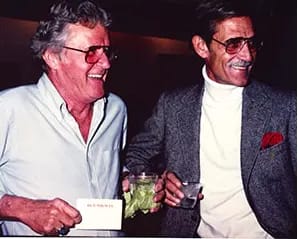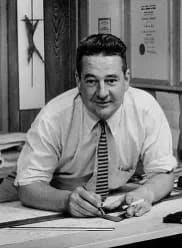Born: Zürich, Switzerland
Education: Institute of Technology in Winterthur, Switzerland, 1924
Best known for: Provocative lines, minimalist concepts, architectural connections to nature, and being a “founder of desert modernism” (and possibly, Palm Springs’ first full-time resident architect). Frey integrated raw elements of the desert, such as hillside rock and boulders, into modern designs of corrugated aluminum, steel, and glass. His Frey House II (which sat at the highest elevation of any home in town when it was built — now part of the Palm Springs Art Museum) and Cree House II for Raymond Cree are unmistakable examples.
With a name synonymous with Palm Springs, Albert Frey is inseparable from the desert’s modernist landscape and the awe it inspires. Since 1964, the soaring crest of the Tramway Gas Station (now Palm Springs Visitors Center) has served as both an iconic welcome sign and a beacon of modern design to every car that turns off Interstate 10 to enter town.
Frey found the desert by way of Switzerland, Belgium, and Paris, where he was one of two full-time employees at the atelier of International Style architect Le Corbusier. Next stop New York to work ip with A. Lawrence Kocher, designing a handful of buildings, including the Aluminaire House in 1931. This futuristic demonstration piece — the first all-metal prefab house in the United States — was relocated to Palm Springs in 2017.
In 1934, Frey landed in Palm Springs to work on the Kocher-Samson Building, a mixed-use structure for his partner’s brother that some deem the first modern building constructed here. Unlike any other environment, the desert stirred him. He hiked the hills, practiced yoga, drove a convertible, and discovered how to use the climate and its terrain for architectural advantage and impact during a post-war boom. Frey settled permanently in his modernist utopia in 1939 and let the desert inform his captivating architecture. It was his home for almost 60 years.
A partnership that began with John Porter Clark, added Robson Chambers, then lost Clark, never broke Frey’s stride. He designed more than 200 residential, commercial, institutional and civic buildings during his long, productive career, concentrated in the 1940s-1960s.
Other Notable Properties:
- Aluminaire House, 1931
- San Jacinto Hotel (Movie Colony Hotel), 1935
- Raymond Loewy House, 1947
- Fire Station No. 1, 1955
- Cree House II, 1955
- Palm Springs City Hall, 1957
- Salton Sea’s North Shore Beach and Yacht Club, 1959
- Palm Springs Aerial Tramway Valley Station, 1963
- Tramway Gas Station, 1964
- Frey House II, 1964










